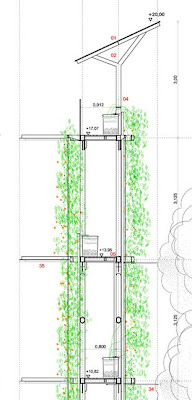Some more on a project I have touched upon this project a bit in a previous post, Eco-Boulevard, from Spanish innovators Ecosistema Urbano. I couldn’t pass up the opportunity to delve into some more of the eye-candy from Arch Daily… and definitely don’t miss Ecosystem Urbano’s great blog as well… which gleans some great urban elements and provides some idea od EU’s inspiration and process.
“The whole proposal for the eco-boulevard in Vallecas can be defined as an urban recycling operation consisting of the following actions: insertion of an air tree-social dynamizer, over an existing urbanization area, densification of existing alignment trees and reduction and asymmetric arrangement of wheeled traffic circulation. Superficial interventions reconfiguring the existing urbanization (perforations, fillings, paint, etc.) that defaces the executed kerb development.”

:: images via Arch Daily
“Three pavilions or trees of air work as supports open to multiple activities chosen by the users. Installed in the non-city as temporary prostheses, they will be used only until the inactivity and climatic adaptation problem is corrected. Once the necessary time has elapsed, these devices should be taken down and the old premises should remain as clearings in the wood.”

:: images via Arch Daily
The descriptions from Arch Daily are great – unlocking some of the info behind the design. There are some duplicates to the previous post I had – but thought I’d repost them for a fuller understanding. The plans are pretty zoomy as well… I don’t think I’d seen the illustrative versions of these prior to this…

:: images via Arch Daily
One interesting thing I’ve noticed is the scale of this development – and really how long of a timeline they have set to acheive canopy closure – based on the coverage of the newly planted plaza trees. This is something where it will be amazing to see intervals of 5, 10, 20 years into the future, as well as what mortality, differential growth, and damage will do to the original concept.

:: images via Arch Daily
And some more dialogue that continues below via Arch Daily: “The air tree is a light structure that is self-sufficient in terms of energy and can be dismantled. It consumes only what it can produce through photovoltaic solar energy collection systems. Selling this energy to the power network generates a superavit on the annual balance sheet and this is reinvested in the maintenance of the structure itself. This is just a model for the management of resources on a project in the course of time.”

:: images via Arch Daily
“The use of technology plays on this project a critical and decisive role as it adapts to an authentic and specific context. The architectural potential of technology lies on its reprogramming and combination with other elements, so that true architectural ready-mades are configured. In this case, climatic adaptation techniques normally employed in the farming industry are borrowed.”

:: images via Arch Daily
“The simple climatic adaptation systems installed in the trees of air are of the evapotranspirative type, which is often used in greenhouses. This aerotechnical practice or artificial adaptation is not a part of a commercial strategy. On the contrary, it tries to undo the leisure – consumption binomial and reactivate the public space by creating climatically adapted environments (8ºC-10ºC cooler than the rest of the street in summer) where citizens will be once again active participants in public spaces.”

:: images via Arch Daily
The details are amazing, and the more I see of this project, the more I like it. It’s utter complexity juxtaposed within the simplicity of concept and idea of deconstructability. Imagine 100s of these in urban areas, not just stuck out in some ‘air farm’ but becoming both the physical and ecological fabric of the city. These have dual function as passive space, display space, and event space as well.

:: images via Arch Daily
And some interesting surprises as well to give some well-rounded experience to users. What looks like a purely functional element on the facade, becomes an artistic lighting element at night.

:: images via Arch Daily

:: images via Arch Daily









jason, do you know where to get that book from a+t or any of their other publications from another source other than europe? it was gonna end up costing me close to 70 bucks just for a magazine after shipping…..bummer.
I haven’t seen it online or through local bookstores – but the book itself is pretty new. You may try to special order or something. The magazines – same thing… perhaps an email to the publishers… to see if they have us distribution somewhere. Definitely worth checking out.
Hi Adam,
If you want to buy THE PUBLIC CHANCE from our website to USA, it would cost you 65€ + 35€ for the shipping costs. If what you want is a magazine, the shipping costs would be 22€. If you buy several publications, dubbing cost decrease.
Anyway, you can see many book stores all across the world where you can also buy it: http://www.aplust.net/distribucion.php?idioma=en
If you have any problem, you can contact us directly at: press@aplust.net
Thanks!